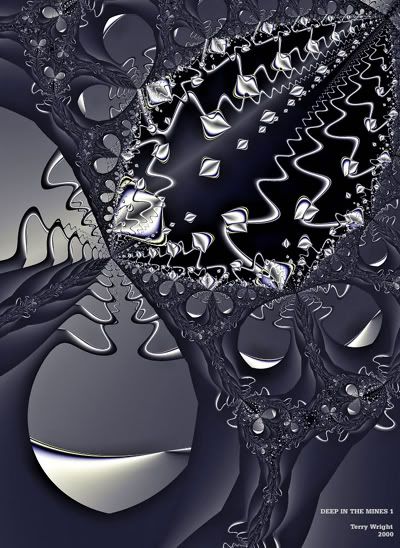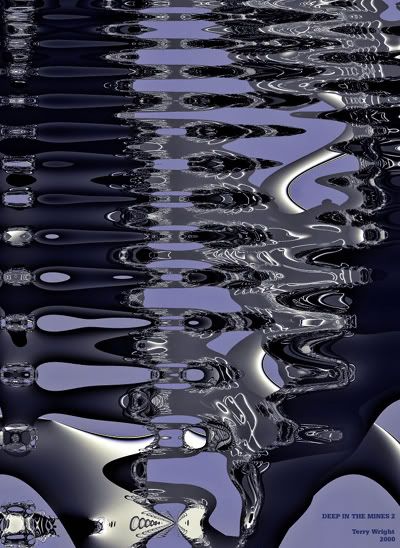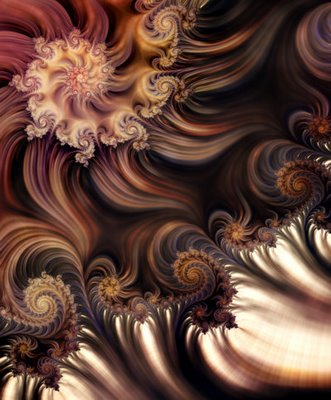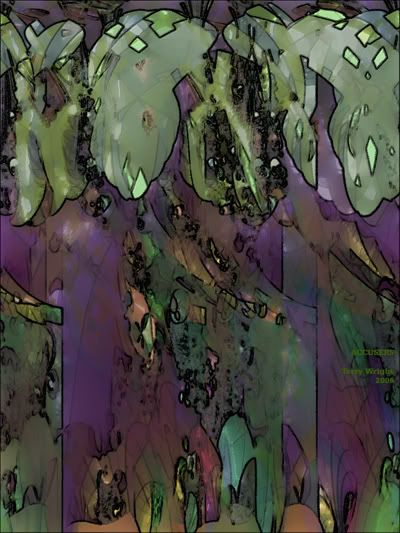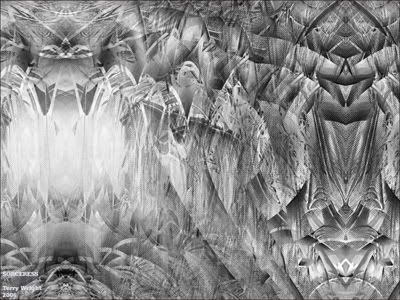Sunday, December 31, 2006
Thursday, December 28, 2006
The Shoulders of Giants
Note: This began as a reply to Tina Oloyede's "Whose Picture Is It Anyway?" post. It got longer than a reply comment ought to be and perhaps wandered a bit afield, so I decided to make it its own post. And it's not directed at Tina specifically any more, except for a little bit at the end.
We stand upon the shoulders of giants.
When creating fractal art with a program like Ultra Fractal, there are many layers of giants on whose shoulders we stand. We use formulas, which are in many cases not just mathematical formulas, but algorithms, programs written by other hard-working people. These formulas run in Ultra Fractal, written by the hard-working Frederik Slijkerman. Ultra Fractal was written with Delphi, a commercial product, the labor of many people. Delphi runs on Windows, a gargantuan product written by hordes of Microsoft serfs (many of whom are bright and creative people). Windows runs on PCs with x86-compatible processors, the work of legions of chip designers for AMD or Intel (or others). These processors operate in motherboards that are the products of still more dedicated engineers.
You can carry the chain back as far as you like, and extend the principle to other fractal tools. The basic concept is the same: when you make a tool, and you share that tool with others, you don't own what they create with it (unless you've specifically indicated so in your license, which would be incredibly crass and is seldom done).
This is different from a derivative work. A derivative work is where you start with someone else's product and produce a similar type of product. For example, if I took someone else's tool and, rather than use the tool as intended to create something, I change the tool. That would be a derivative work and may infringe on a copyright. (It depends on the tool's license.)
Of course I don't think Tina was asking a legal question, and that's good, because I Am Not A Lawyer and This Is Not Legal Advice. Rather, I think Tina was asking a more complex question. I sometimes think in terms of "strong" and "weak" formulas and tools.
A "strong" tool is one whose effects are so powerful, so distinctive that, to those who are familiar with the tool, its use is indelibly etched into the work. In UF terms, this would be particularly obvious algorithms (Triangle Inequality Average, anything with fBm in it, etc.) At the next level it would include tools like Apophysis. Things so distinctive that it's hard to create with them without it looking similar to other things created with that tool.
"Weak" tools are just the opposite; they leave plenty of room for the artist's own style to show through, because their own specific traits are less blatant.
The interesting thing is that although I have named my tool categories based on their obviousness in the products of those tools, if you were to name them based on the tools' flexibility and capability the labels would be flipped. A "strong" tool in the obviousness sense is a "weak" tool in the flexibility sense. So really, "weak" tools can be much better, because you have so much more freedom. Of course, this does mean they take more time to learn.
Where it gets really tricky is where an artist's style is based on a strong tool. This is what we ask of artists: that they be creative. The more "strong" tools an artist uses, the more their style comes from their tools, rather than their choices in using those tools. Is the artist really expressing themselves? Or just pushing buttons until they get something pretty? Is it the artist, or the tool? (This is very much what Tina was getting at.)
We have this angst, as fractal artists. Some of us have had experiences where, once we describe what we do, people get in a huff and say, "well any chimp can do that!" I've personally been called out on this during a presentation I was giving on fractal art. So sometimes we are very insistent that fractal art is art. But there will always be people who think that, because we do it with a computer, we are not really being creative, and this is an idle pursuit. That we are dilettantes, dabblers, not really artists. This would not bother us if we didn't have a little sliver of doubt within us, or if we couldn't point to plenty of people for whom those labels apply (and who do not seem to be bothered by it like we are). Are we really artists? Will there be a fractal Renoir, or Picasso, or da Vinci? Will any of this be remembered in twenty years? Fifty? Two hundred?
This is our elephant in the room. We feel that sometimes our tools make things too easy. We want to be visually distinct from each other. But we all use the same tools. So we're afraid that an outsider will look at our work and think it is all the same. That we really didn't contribute much. And we're afraid that maybe they're right. Because most famous artists didn't make six hundred images in ten years. The fact that we can produce so much suggests that perhaps we didn't put as much of ourselves into it as we ought.
My suggested cure is not very complicated.
- Approach "strong" tools with caution. Use them judiciously. Overusing them is a crutch, an easy fix. If your style depends largely on tools someone else has created, broaden your reach. Try something new.
- Prefer more generalized tools, that leave you room to express your own style. If you develop your own style that is distinct from the "normal" things your tools do, you will know that it is you who is in charge, not your tool-maker. This has the added benefit of giving your more confidence in what you're doing.
- The best fractal artists are those who know enough about their tools to be able to imitate the styles of other artists. If they can do that, then you know that they are making choices about how their art looks because they can, not because it's all they know how to do. Practice doing this. It is a very educational, confidence-building, and skill-building exercise.
- Spend lots of time with each image. This is something I am still learning to do. Don't let an image out until it's really ready. Filter, filter, filter. Keep all that bad stuff; hard drive space is cheap and parameters are compact. Look at your old stuff from time to time to remind yourself how far you've come. Periodically rework an old image that you didn't feel was quite done. Over time your standards will go up and your "productivity" will go down. That's OK. Great art is seldom made in five minutes.
If fractal artists want fractal art to be taken seriously as art, then above all what we need to prove is that fractal art is the expression of artists, not the default representation of basic mathematics. So, master your tools and force them to express what you want.
Specific reply for Tina: the images shown clearly bear the traits of the tools used. And yet they also show your style. Tool-makers love to see their tools used; that's the point of sharing the tool in the first place. But the best, most satisfying thing for me as a tool-maker is always when someone uses the tool to do something new that I never thought of.
Wednesday, December 27, 2006
Fragmentation and Alienation

The following is a montage of some quotes I found in the web about the eruption of the Tambora volcano and the so called "year without summer".
The place was Sumbawa, Indonesia, the year was 1815, and the month was April. Everything was set for one of the most explosive events in human history. Sumbawa Island is home to the volcano called Tambora which has an elevation of 9,348 ft. (2,850m) and a diameter at sea-level of 38 mile. On April 5th of 1815 the volcano, which had lain dormant for more than 5,000 years, began to erupt.
The mountain had been experiencing small eruptions before it exploded in 1815 and the April eruption left a deep summit caldera where the previous stratovolcano stood, causing earthquakes as far away as Surabaya (a distance of 500 km) in reaction to the collapse. Ash exploded from the eruption and was carried as far as east Java, approximately 900 km from Tambora. Thunder-like sounds were heard up to 1,400 km away and the entire eruption is estimated to have had the volcanic explosion strength of seven. The eruption column itself was roughly 44 km high vertically and produced numerous pyroclastic flows. Tsunamis were generated as a result of both the flows and the shock waves from the collapsing caldera. In total, the volcanic eruption lasted for two days and ejected about 50 cubic km of magma. The eruption was the largest that had occurred over past 1,000 years, with an immediate human impact of 92,000 deaths.
The explosion obliterated one civilization in particular. The Tamboran kingdom of Sumbawa disappeared in 1815. Not much is known about the civilization, which was unknown to the Western world before the early 1800s. The first Dutch and British researchers to visit the island were surprised to find the inhabitants speaking a language unlike any other in Indonesia. Some believe the 10,000 Tamborans spoke a language in the Mon-Khmer family, resembling those spoken in Indochina. Most evidence of the civilization was lost to the ash and stone of Tambora's pyroclastic flows.
In Indonesia, over 100,000 people died shortly following Tambora's eruption Some lost their lives in the deadly whirlwinds and tsunamis that followed in the summer of 1815, while others succumbed to famine and disease. Add to that number victims of typhus and cholera, and one is aware of the far-reaching power of this nearly 200-year-old natural disaster.
As far-reaching as the immediate outputs of the volcanic explosion were, the full effects of the eruption had yet to be felt. The year after the eruption, 1816, is often titled "the year without summer," due to significantly cooler temperatures throughout Europe and other reaches of the world, resulting in such unusual phenomena as snow in June in the northern hemisphere and cyclone tracks being pushed to the south, bringing unusually wet weather in many areas. Crop failures and famine abounded the world over, marked by higher death rates that exceeded anything on Earth in the past 10,000 years. "The year without summer" is not a complete mystery, however, for its causes are the typical results of a large volcanic explosion, such as the Tambora eruption. There are many who would disagree with this hypothesis, claiming that the effects of a volcanic eruption the size of Tambora could not be as far-reaching or as destructive to cause "the year without summer."
Global cooling caused crop failures, summer snowfalls, famine, floods and epidemics in 1816. Temperatures in North America and Europe dropped an average of five to six degrees Celsius, producing widespread crop failure, with disparate results. Winter and spring in Quebec and the eastern United States were near normal, if a little dry, giving no indication of the unusually cold summer to come. Although daytime highs remained relatively normal, extreme drops in nighttime temperatures led to frosts in April and May that killed or damaged corn and fruit crops. The surprising snowfall on June 5 and 6 that blanketed New England was an indication of what would follow that summer. Further frosts through the usually temperate months killed corn, fruit and vegetable crops from Maine to North Carolina. Animals, particularly birds and newly shorn sheep, died of exposure in Vermont. The poor weather conditions had a notable result: food shortages drove many New England farmers westward.
Conditions in Europe were worse. The altered weather had adverse effects on French crops, greatly reduced the food supply. Wholesale failure or late harvesting of grapes due to frosts resulted in a practically nonexistent grape harvest. Food riots broke out in Britain, Switzerland and France triggering the looting of grain warehouses. Widespread famine in Switzerland caused the government to declare a national emergency and release instructions for distinguishing edible plans from poisonous ones. That year, the British government abolished income tax because of severe food shortages.
Perhaps Ireland endured the most dismal consequences of the changing climate. An exceptionally wet summer, with rain falling 142 out of 153 days, led to a wholesale destruction of wheat, oat and potato crops. An estimated 60,000 people died of famine or famine related diseases in this, Ireland's first major potato failure. A wave of emigration followed.
The lowered temperatures and particularly moist conditions also played a pivotal role in the rampant spread of disease in 1816. Scientists frequently blame Ireland's rainy summer for the typhus epidemic of 1816 to 1819. The epidemic later spread to Europe and ultimately claimed the lives of 200,000.
I´m vividly touched by the fact that an entire people desapeared at the initial explosion of mount Tambora and it´s language was gone as well at that moment. My visual poem try to suggest a way of experiencing the material destruction of the language. The poem is fragmented and confusing. The words and letters proced disjunctively, like some fearful dream, while the fractured syntax articulates the proposal of its own destruction. The fragmentation of the poem proposes to alienate the reader from the lecture itself. There isn´t a lecture. There isn´t something to be read. There isn´t reasons to understand something. There is nothing. Life is gone! The language is missed. Nobody knows the name of the stars. Nobody knows the names of the fruits. And the name of the river is missed. Nobody will say it again.
These elements can be interpreted as reflecting a wasteland of language. Grammar is barren and meaningless, sentences are dead husks and the occasional tattered bit of coherent meaning waves aimlessly about in a dry wind of purpose. As a result, the "reader" cannot claim familiarity with the basic mechanics of the language. The fragmentation of the language alienates the reader further. The desolation and confusion that the poem presents to the reader is balanced precariously by the sheer wealth of knowledge and history behind the piece.
The folded surface was produced with Ron Barnett´s Formula Tracer with the formula variation Cayley Cubic. The coloring formula is Texture Raytrace, both of them among my most favorites tools. And the words in Portuguese (what an exotic language!) are created with Photoshop and processed into UF with Mark Townsend´s, Sprite.
There is a vivid description by Lord Byron of the "year without summer", wich you can read here.
Deep in the Mines
Deep in the Mines 1 (2000)
Fractals sometimes transcend their parameters. If they are art -- and I'm guessing that most of us think they are -- then our images reflect some deeper part of ourselves. Our dreams. Our buried treasures.
Tina got me thinking about this standing on the shoulders of giants business. It's true that someone built the mine by writing a program or a formula. But the artist still has to take that journey to the underworld and cart back the gold or silver.
It's a dangerous business. Rooting around under the surface for meaning. Sometimes you strike it rich. Other times what you find blows up in your face.
And there's no drop dead canary telling you when your image glitters or smells like gas.
Deep in the Mines 2 (2000)
I've often used the word spelunking to describe my artistic process. I crawl through images -- hauling out dirt, clearing a path to see what still lies ahead. It can be claustrophobic. Sometimes I chip away at one delicate section for hours. Sometimes I thrash around blindly. Even a cave-in is better than finding nothing.
Maybe someone caved or carved out parts of this mine before me. But I'm still the one who has to go down there -- again -- alone -- in the dark.
The classics are filled with treacherous journeys to the underworld where ghosts linger and are haunted by their memories of life. Maybe, like Orpheus, my images will sing, and I'll return to the light with something I love. Unless I get impatient. Unless I turn around to look at what I've made before the trip is finished. We've read the story. We know what happens then.
I think fractals can reveal memories from the substratum. They flock around Odysseus at the pit of blood. If you risk going underground, they might settle around you like leaves encircling a tree. Or they might mock you from the safety of the shadows.
They are more than "the cold equations" of Tom Godwin's moving story. They are like engrams. Brain scans anyone can read.
There's plenty of uranium deep in the mines. With it, you can see inside yourself.
And see through others, too.
Deep in the Mines 3 (2000)
Mine.
Mind?
Dig still deeper...
Deep in the Mines 4 (2000)
Sometimes I wake up in the middle of the night. I have bits of poems or images partially unburied in my head. I've learned to get up immediately and start shoveling with my pen or keyboard. If I don't, those whispers from the Muse will vanish like Eurydice.
Here's something I wrote in my notebook several years ago in a semi-sleepwalk:
The mine
is darker than
the last thing you
said
to me
ten years ago
today.
Someone probably said something similar before me. Maybe I should have left this lump of coal resting under tons of rock.
But we don't, do we? We open our notebooks and our programs -- and, with dim light pouring from our foreheads, we start digging.
And, sometimes, if we persevere and are lucky, we uncover something.
A nugget pick-axed out of the ore.
A diamond hewn from the darkness of the subconscious.
Rare chunks of art hauled out from deep in the mines into the open air for all to see.
Tuesday, December 26, 2006
Whose picture is it anyway?
Just whose picture is it anyway?

Is it mine or does it belong to Benoit Mandelbrot et al?
Of course, I'd like to think all the art that I've created over the years is belongs to me and at least, as the currently accepted copyright issues go, that is the case. In effect, the formula writers who have uploaded their formulae to the public database, and who hold copyrights to those formulae, have granted a free license to me and other fractal artists to use and manipulate their work in such a way as to produce a unique image for which the artist has a right to claim full copyright - over and above the copyrights of the formulae used.
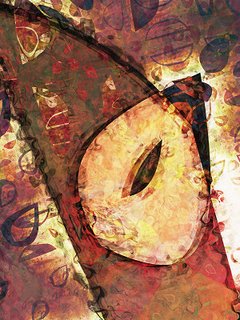
Tina's or Sam's?
To my eye there is no mistaking the talented hand of Samual Monnier in this picture and yet he does not own any rights to it. There is no possible way that I could have sat down with a blank canvas, so to speak, and created this "Pickled Pear". It is essential for me to have the tools that others have created to hand in order to create.
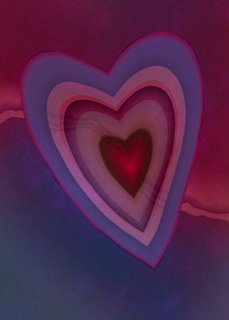
Mine or Damien Jones'?
I don't wish to labour a point (more examples below!) but am interested to know how other feel about this issue - especially the formula writers themselves. Is there any regret about freely dishing out your formulae to all and sundry or does it give you pleasure to see art being created from it?
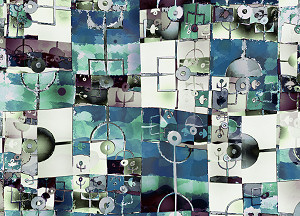
I can't look at this image without seeing its origins from Andreas Lober
Do other artists share my own anxieties about just whose picture it is anyway, or is it just me?
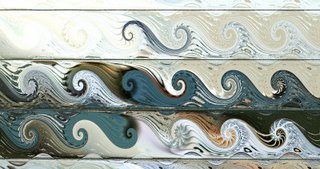
It couldn't have been created without Mark Townsend & Denis Magar
Sunday, December 24, 2006
Space Heads

Sasquatch, UFO's, Bermuda Triangle, and now --Space Heads.

What am I talking about? Imagine that outer space is something like the ocean: mostly empty but "infected" with life. We don't expect to find something. We don't expect to get a cold. But we're not surprised when it happens. Probability says, it's going to happen, instinct says, not today.

Space Heads, the micro-plankton of the space: floating, primitive ...collectible.

An extra z here, a cos instead of a tan over there. Change the + to a ^ and you've got a new Space Head. Or just some new space.

Tiera-zon 2.7 parameter files (.zar) "spaceheads.zip"
There's fractals and then there's the other stuff, hard to categorize or describe: Floating; unconnected but associated; head-like. Space Heads.

They are primitive because they are basic and close to the trunk of the tree, unlike ourselves, complex creatures, who form the distant tip of a limb. It's no surprise to find them represented in the fossil record; ancient, the earliest of iterations, almost timeless, drifting in time.

Haven't fractal generators changed the world? Before, there was the wilderness -the natural world, and there were the cities -the places of human design. But now there is a new place, half-natural, half-human, neither of those, transcending both.

On the frontier, few things are labelled and nothing is categorized. The question, "What is it?" has not yet occurred. We look, we wander, we forget what brought us here.
Saturday, December 23, 2006
Joy to the World

It is that time of the year. I'm hearing the music in all the shopping malls. I'm seeing Scrooge and the Grinch on TV. All the signs point to it. Every time I hear John Lennon's "And so this is Christmas, and what have you done?", the answer that flashes through my mind is - NOTHING! Well, it's not really that bad. For me, making fractals is a rapport with my maker, even if I don't always live up to the relationship :-(. So as it's Christmas, I'll wish a Merry Christmas to those who subscribe to it, and others can substitute, "Joy to the fishes in the deep blue sea/Joy to you and me" :-)
-
My condolences to Juan Luis on the loss of his mother. 59 seems a very young age to go. The Christmas season can indeed involve sadness.
Friday, December 22, 2006
Thursday, December 21, 2006
Omission
The early 20th century ballet impresario, Serge Diaghilev, wrote "Omission is the essence of art."
In the second of my courses on using Ultra Fractal at the Visual Arts Academy, I teach many techniques for using mask layers to judiciously add elements to or remove them from an image. I use masking extensively in my work, as described in a previous Orbit Trap post, because it allows me to introduce subtleties of shading and texture into an image.
To demonstrate what I mean, I'll use a recent work that ended up totaling 10 host and 13 mask layers. First, here are just the 10 merged host layers, without any of their accompanying masks:

This image has interesting variation in color, and a good deal of contrast between dark and light areas created by the coloring formula; the textures I've used appear equally in every part of the image, but the overall effect is still quite flat. My eye doesn't really know where to look because there's so much going on and each area of the image has the same impact – not unlike a middle school band in which each of the participants is playing the right notes, but all at the same a-little-too-loud volume.
Now here's the finished image – exactly the same 10 layers, in the same order with the same merge modes, but now with their respective mask layers attached:
I've used the mask layers to take away elements of the image – texture, color, structure – in order to create the illusion of depth and shading. They create areas of interest that attract the viewer's focus and areas of stillness that allow the eye to rest. The areas of dark next to light don't just provide contrast in tone, they create a sense of depth and dimensionality that was missing above.
I realize that my stylistic preferences are not shared by everyone. That's ok. But I also wonder what folks might discover in their fractals if they thought about subtracting rather than adding elements.
Wednesday, December 20, 2006
The worst enemy

At the South hemisphere we are going to face the worst summer season of the last twenty years. Temperatures about 2º Celsius grades above the normal rate are expected. Normally at the summer in Rio de Janeiro we are dealing with temperatures of 40º Celsius (F 104º). Easily the temperature races up to F107º. From now on there is no limit anymore.
We have a law that restricts all activity in schools, industry and commerce when temperatures are going above of 40ºC - I would say that such a "restriction" has been applied only during the three days of Carnival - and not because of the high temperature. The reason is because we get nuts at that time!
It´s impossible to concentrate in real deep and valid questions. Can you imagine what sacrifice means to read Kant´s Critique of Pure Reason at a hot summer day in a tropical restless city? You´re loosing your time. Your brain simply does not go to function for that. And this is the true reason I´m writing such an idiot text like this one. Comments about weather and temperature are usually the most boring subject of conversation, aren´t?
Before I get exausted of my hard efforts to type something and you switch the blog, let me tell you an old joke where a guy walks into an astronomy lecture and listens to a professor talking about the fate of the Sun. "In a billion years" the professor says "our star, the Sun, will run out of fuel and die". The guy raises his hand and says, "How long did you say we had?" The professor repeats his billion-year prediction. "Whew," says the guy, "I was getting worried. I thought you said a million years!"
So, unfortunately we have a billion summers more. What a messy life!
Tuesday, December 19, 2006
Monday, December 18, 2006
Putting the Art in Fractal Art
Chump Change (2006)
The way I saw my art changed when I started working with a master printer to make poster-sized Giclees of my own work. I began to see my images on the wall rather than on the screen.
My work habits shifted noticeably. I started creating in the largest sizes my poor computer could tolerate without coughing and crashing. Each new image became a canvas, and my eyes adjusted to looking at sections of a big picture work-in-progress rather than conventional monitor sizes.
And, suddenly, the details and nuances of texture became paramount.
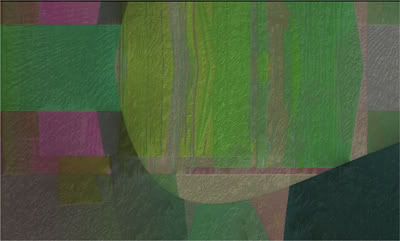
Upper left corner detail of Chump Change
Size became whatever I could muster. Memory became my enemy. My work computer has four gigs of RAM, and I can work at 8000 x 8000 pixels -- usually -- unless I want to post-process heavily.
And I do -- with extreme prejudice -- which cuts down my comfort zone closer to around 6000 x 6000 pixels. But I can thrash about in Photoshop or Painter with wild abandon and still layer/render away at a steady clip.
And why post-process? It's really not for the fractal. After all, it's already there (or, at least, what's left of it).
I post-process for the art.
Accusers (2006)
But I'm getting ahead of myself. Let's go back to the beginning.
I didn't get into fractals for the math. I took them up because -- finally -- I saw a way that I could make art.
I'd tried before. I took a beginning art class when I was college. It was a frustrating experience. I couldn't make my paintings look anything like what I saw in my head. The professor eventually suggested I drop the class -- while adding, for good measure and for the benefit of my long-term self-esteem, that I "probably had no talent."
I know what you're thinking. Don't say it.
But the prof was right in one sense. I couldn't deal with the conventional tools of art. The brush seemed pudgy and awkward. I always felt like I was stabbing the canvas with a cucumber. I never could gage how much or how little paint would produce the desired thickness. Everything dried too fast or dripped too much. And the smell of the chemicals gagged me and made my head feel like a cinder block.
I gave up -- and took up writing instead. The pen felt just fine in my hand, and I had an overdose of images already in my head.
Then, one day in 1997, I saw my first fractal on Usenet.
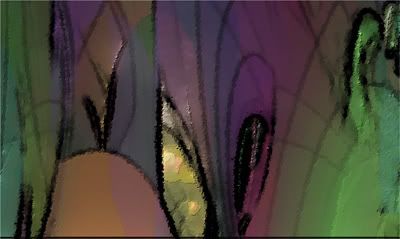
And I've been playing with fractals ever since. At first, I just churned 'em out like an assembly line. I was fascinated by how minor adjustments produced subtle changes with each subsequent iteration. Sometimes, I felt more like a machine than the computer itself.
But I slowed down considerably once I began to post-process. I started to labor over images and refused to be satisfied until each was either finished (abandoned?) as the closest approximation of my head shot -- or every layer was sent kicking to the Recycle Bin.
And that's when I realized I'd found a way to begin painting. Fractals became my base canvas. I wasn't afraid, to the consternation of some, to mess everything up. The fractal forms weren't sacrosanct to me. Only the final result mattered.
I believe making art is like a knife fight. There are no rules. You either survive the ordeal with something from nothing to show for it. Or your vision dies.
Sorceress (2006)
So, now, I was "painting" regularly, composing more carefully, and doting over textures -- at least, those I could see working within a scale of 800 x 600 pixels. Still, I found myself wondering: Am I making art?
And how would I ever know unless I could really see what I was doing?
But, as I said, everything changed after I met with a professional printer and saw my first poster-sized Giclee. I had new improved eyes -- and with fresh sight came further adjustments in my process. I worked even more slowly. I realized my early images were like a cup of black coffee. The latter ones became like a tongue-twisting, labor-intensive specialty coffee from Starbucks.
Thinking big is like making the jump to high-definition television. Textures matter. Every pixel shows. And once that mindset took hold, I finally felt like I was thinking like an artist.
I'm glad I worked with a professional printer -- an artist himself -- because he had the experience and the equipment to make a museum-quality product. Acid free inks and papers make a difference. And although photographic prints are lush and can scale up quite large, I was drawn to the gentler (as in less saturated), smaller Giclees. Surfaces in Giclee are remarkably tactile -- with brush strokes evident and raised and indented areas becoming peaks and valleys. And the first time I saw an image printed on canvas and covered with a chemical wash, I knew...
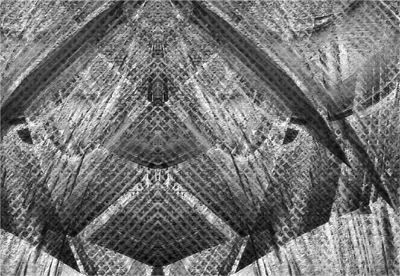
...I knew I was looking at a painting.
A program like Fractal ViZion (which I like, by the way) can produce endless fractals with one mouse click. It doesn't need us to produce fractals. Besides, nature's already doing a fine job of churning them out -- thank you very much.
And, although I don't use Ultra Fractal, I think I understand (at least in part) why so many fractalists are drawn to it. The software can produce striking, intricate textures. I know that's why I was excited to help beta-test XenoDream. It wasn't for the 3D forms. It was for the incredibly lush and complex textures.
I'm not advocating my way or the highway, you understand. I'm just encapsulating my journey to finding art in fractals.
I do believe fractals can be more than what math wrought.
And much more than decoration.
They can be fine art -- and all that goes with it.
So don't be afraid to paint -- whether in-house with UF or XenoDream or outsourced to Photoshop et. al. And don't shy away from seeing the small screen as the big picture on your wall.
Yes, we have the tools. But we also need to cultivate the vision -- along with the talent and patience to bring it into existence.
We put the art in fractal art.
Sunday, December 17, 2006
Flames over Tokyo

It's never been my intention to talk about war and depressing stuff like that, but I like this image and all I can think of when I look at it is the B-29 fire-bombing campaign that took place over Japan in the spring of 1945.
I read the diary of an allied soldier who was a prisoner of the Japanese working in a coal mine in Japan during WW2. The entries were very routine and written every day without exception for the duration of the war from Dec. '41 to Aug. '45.
My Grandfather had been part of this group of 2,000 Canadian soldiers, just like the author of the diary had. They went to Hong Kong in November of '41 and fought from Dec. 8th until Dec. 25th when the British colony surrendered.
Although my Grandfather's been dead for almost 15 years, I joined a veteran's organization whose purpose is to comemorate their memory as well as look after the interests of those surviving Canadian veterans who fought in the Battle of Hong Kong. I wanted to get some understanding of what the veterans went through so I could relate to them better, and I thought reading the diary's exhaustive, day to day account would do that.
Can someone like me really understand these war experiences? Possibly not, or at the most, only in a limited way.

(With regards to the image above, this is the original image from Inkblot Kaos from which it was made, with the help of Illyich the Toad's multi-crystal.8bf and Martijn W. van der Lee's, Ink Rubber.8bf ("inkrubbr.8bf") which tinted it.)
The guy who wrote the diary was very methodical and disciplined. He never missed a day, even if there was nothing really to write about. He soon fell into a routine of writing two sentences a day about his experiences as a POW working as slave labour in a Japanese coal mine. It became a ritual.
Until the spring of '45 when the regular entries abruptly stopped.
I knew he hadn't died. He survived and came back to Canada after the war like my Grandfather did. But camp life for the author was turned upside down and it seemed to have something to do with a sudden change of events in Japan associated with Allied bombing.
The war ended and the author left Japan in September of 45. While enroute by train to board an American ship homeward, he saw the ruins of Nagasaki, destroyed only a month previously by the second atomic bomb.
So what had happened that caused this man to stop writing in his diary for a whole month? What was going on that had such a profound effect on the behaviour of the prison camp guards that he thought they'd kill him for the slightest reason such as possessing a diary?
I found out by reading a book called Flames over Tokyo by E. Bartlett Kerr. The catastrophic events were the B-29 incendiary bombing campaign that literally burned up most of Japan's major cities in spring of 1945. Most people know about the atomic bombings of Hiroshima and Nagasaki, but few, including myself, know much about the fire-bombing campaign that went on all over Japan and was actually much more destructive, although less "glamourous" to write about than the atomic attacks.
To make a long blog posting short... back in the 40's most of the buildings in Japanese cities (even large parts of the national capital, Tokyo) were made mostly of wood. European cities had much more brick and concrete construction which made the strategy of fire-bombing less appealing, but for Japan this was it's achilles heel.
Add to all this the brand-new B-29 ("SuperFortress") with increased bomb load and extended range of operation, and then the newly designed incendiary bombs, in clusters, made with "jellied" gasoline (napalm), designed and tested to puncture a roof and several floors of a wooden Japanese building and squirt on impact...
Once the fires got going, some of the flight crews in the next wave of bombers said they could actually smell the fires -and burning flesh. They weren't flying at 30,000 feet like the new "pressurized" B-29 was capable of. They were flying at a few thousand feet, at night, to maximise accuracy and minimize losses. Less like flying, and more like driving, through Tokyo.
Well, so what? War is pretty awful and destructive all the time isn't it? Yeah, but in these cases huge chunks of the city were obliterated (and the people in them). Not just a few isolated, industrial areas or strategic targets, but something like 40, 50 or 60 per cent of the whole city. In a few Japanese cities, upwards of 90% of the urban area was burnt to the ground after only two or three bombing missions.
The war that had so far been foreign and far-away, all of a sudden came home.
Sunday, December 10, 2006
Winter

"A winter's day, in a deep and dark December... I am a Rock! I am an Island! MUAHAHAHA"
"While I looked around, for my possibilities, I was so hard to please, and the sky, is a hazy shade, of winter."
"When I look back on all the crap I learned in high school."
Tsk tsk tsk, there goes Rhymin' Simon...
Was there a point to all this? Not really, it's just cold here. :-) I will say it was rather hard to "sign" this fracky... all the colours I tried blended in real good... ;-)
Friday, December 08, 2006
The Varieties of Deadly Experience

Forest of Knives
I remember back during the last few years of the Vietnam war, in the early 70s, reading an article in the magazine that came with the weekend edition of the newspaper, about the various booby-traps the enemy was using against US soldiers.
I was 7 or 8 at the time and living on the edge of a small pulp and paper town up in Northwestern Ontario (sparsley inhabited wilderness). Me and my brothers spent most of our time out in the bush making forts and hiking around, so we were fascinated with the eleborate mechanisms the NVA and VC were making with sticks and other natural materials.

Sharpened bamboo covered with pig manure was a common ingredient in most constructions, as was the occasional venomous snake tied to a stick. It was all pretty exotic for someone growing up in a world of spruce trees. The only threat to my well-being was having my favorite TV show pre-empted by a football game.
The magazine article was part of a series, and the next week featured the high-tech booby-traps of the American forces. They weren't quite as interesting; all of them were more or less variations on the theme of explosives blowing pieces of steel around. None of them were hand-crafted, and in the full-colored drawings they just looked like little plastic boxes. I gave them second-place in the creative design category.
What caught my attention, and still does to this day, was how to set up a series of claymore anti-personnel mines so the enemy soldiers would actually jump on them, or at least run towards them, just before they exploded. That made the little plastic boxes more interesting. I remember me and my brothers having quite a few arguements trying to second-guess the enemy's response, and therefore where to place the second (third, fourth...) anti-personnel mine if our living room was ever infiltrated.
It's like a well thought out chess manoever, but with different equipment. For instance, you hear a big bang, you turn away from it or move away. It's human nature to minimize injuries. So the second one goes over where you would run to get away from the first. The third is placed in the same way.

Later on we applied this technique to kill houseflys. Imagine a housefly sitting on a table. You move forward and try to hit it by smacking your hand down on the table. It rarely works because the fly sees the hand coming and flys up and away.
So what you do is take your hands and clap them together above the fly, or above the place the fly is when your hands start to move. The fly jumps up when your hands start to move, and literally flys up into your hands. If he he'd just stayed where he was on the table, nothing would have happened to him.
The fly is faster, and you can't compete with his speed and agility, but you're smarter and you know where he's going. The slow hand gets the fast fly.
Wednesday, December 06, 2006
Do the tools matter?
 This morning I made an image with Ultra Fractal that wasn't fractal at all. This is not the first time I've done something like this, although with tools like DeluxeClipping and glyph it was much easier than it used to be. But as you can clearly see from the image above, this would have been trivial to do with something more appropriate for the task, something along the lines of Adobe Illustrator. To create something like this purely within UF is a peculiar kind of masochism.
This morning I made an image with Ultra Fractal that wasn't fractal at all. This is not the first time I've done something like this, although with tools like DeluxeClipping and glyph it was much easier than it used to be. But as you can clearly see from the image above, this would have been trivial to do with something more appropriate for the task, something along the lines of Adobe Illustrator. To create something like this purely within UF is a peculiar kind of masochism.This just makes me think of hyper-realist painters, people like Bert Monroy. Monroy creates his fine art with Photoshop and Illustrator and, if I didn't tell you that first, you would just assume they are photographs. Why would someone spend so much time creating something by hand that is indistinguishable from a photograph? On his site, Monroy states "To me, it is not the destination that is important—it is the journey. The incredible challenge of recreating reality is my motivation."
Hmmm. I can certainly say, as one who has merely modest skills with Monroy's preferred tools, that his skill is breathtakingly extensive. For him, the process makes all the difference. But should anyone else care?
And why am I picking on Monroy, when clearly the man can wield a mouse with panache? Because he reminds me of a dancing bear. If you ever see a dancing bear, you will be duly impressed; not because the bear dances well, but because the bear dances at all. So it is with hyper-realistic painting. So it is with doing rudimentary vector graphics in Ultra Fractal. It is only remarkable because it can be done at all. Remove the means, and you have little of interest.
This morning's non-fractal was not a serious attempt at art. It was a quick sketch to have a bit of fun. At least I know that. The really interesting stuff will be from combining these vector graphic tools with real fractal manipulation.
(UF parameters for the above image)
Monday, December 04, 2006
Francis Bacon is the guy!
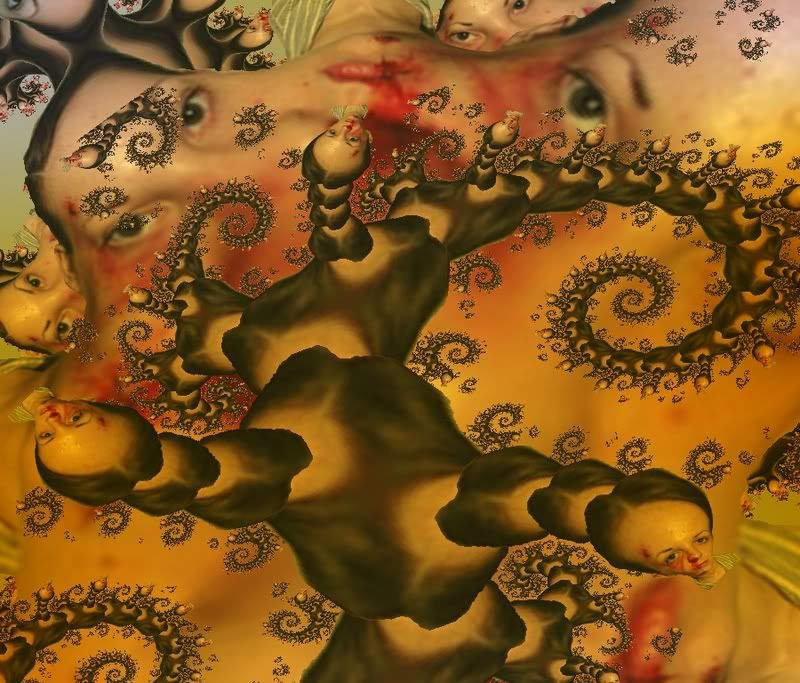
After I made "The Abuse" with a picture of a seriously injured girl found in the web I couldn’t avoid thinking about Francis Bacon and his unpleasant images of corrupt, violent and disgusting humanity. Bacon deliberately subverted artistic conventions to show "the evils of man, rather than the virtues of Christ" and caused repulse with his nightmarish imagery of half-human, half-animal creatures. "Visitors were brought up short," wrote the critic John Russell, "by images so unrelieved awful that the mind shut with a snap at the sight of them".
Typical of his paintings in the 1950s were his Screaming Popes, a series of pictures based on Velázquez's serene portrait of Pope Innocent X, but distorted into images of hysterical fear and alienation.
The men I painted were all in extreme situations, and the scream is a transcription of their pain.Some of his figures were shown alongside sides of raw meat. Many appear to be enclosed in glass boxes, suggesting isolation and despair.
Ham, pigs, tongues, sides of beef seen in the butcher’s window, all that death, I find it very beautiful. And it’s all for sale—how unbelievably surrealistic!
Critics and the public alike admired his ability to use oils with a sumptuous richness to express images of horror or degradation.
Flesh and meat are life! If I paint red meat as I paint bodies it is just because I find it very beautiful.
In his paintings the human face and body are subjected to extremes of contortion and distortion.
My painting is not violent; it’s life that is violent. Even within the most beautiful landscape, in the trees, under the leaves the insects are eating each other; violence is a part of life.
The paint is used to smudge and twist the subjects into formless, slug-like creatures of dark and horror fantasy.
Painting can be as violent as fucking, like an orgasm or an ejaculation. The result is often disappointing, but the process is highly exciting.Heavy drinker and gambler, Bacon’s personal life was dissolute.
I have no moral lesson to preach, nor any advice to give.
He was also homosexual and lived extremely hard core experiences at his "sex-haunting expeditions" on the streets of London and Paris.
I have been lucky enough to be able to live on my obsession. This is my only success.
Despite his paintings race up to huge prices he cared hardly at all for material possessions:
I want to die as I was born: with nothing.I saw a documentary about his techniques and I must say that his studio was a real "horror’s chamber", so dirty, poor, dark and rotten it was.
When I paint I am ageless, I just have the pleasure or the difficulty of painting.
Well, today I woke up praying for Bacon to get more of him and on the same direction.
You could say that I have no inspiration, that I only need to paint.And also I must praise Mark Townsend for his extraordinary invention: Sprite!
With Sprite artists have a new dimension opened for the most vivid experiences of visuality on fractals.
The creative process is a cocktail of instinct, skill, culture and a highly creative feverishness. It is not like a drug; it is a particular state when everything happens very quickly, a mixture of consciousness and unconsciousness, of fear and pleasure; it’s a little like making love, the physical act of love.
Sunday, December 03, 2006
Homage to Andy Warhol
Homage to Andy Warhol (2000)
From artrepublic:
In 1960 Warhol began to replicate a range of mass-produced images, beginning with newspaper advertisements and comic strips before turning to packaging, dollar bills and more. He is probably the most famous member of the Pop Art movement. Virtually any image that was in the public domain was a prime target for the Warhol treatment. In 1962 he had his first one-man show at the Ferus Gallery in Los Angeles and in the same year exhibited at the Stable Gallery in New York. This was the year of 32 Campbell's Soup Cans (1961-1962). Soon after his sculptures of Brillo soap pad boxes, Coca-Cola bottles and replications of popular icons such as Elvis Presley, Elizabeth Taylor and most famously Marilyn Monroe were to appear and secure his reputation. The silk-screen process he favoured allowed for infinite replication, and he was opposed to the concept of a work of art as a piece of craftsmanship executed purely for the connoisseur; in Warhol's own words, "I want everybody to think alike. I think everybody should be a machine."
Thus Warhol's work was intent on dehumanising his subjects whether they be images purloined from mass-culture or depictions of atrocities such as car crashes. He turned out his works/products like a manufacturer, going as far as naming his studio The Factory. As well as paintings, he published the long-running celebrity magazine Interview, managed the rock group The Velvet Underground and achieved great notoriety as an underground filmmaker with lengthy films such as Sleep (1963) and Empire (1964). In their silent and almost completely static images Warhol raised monotony to new heights, as he said at the time, "I like boring things." Andy Warhol has become one of the icons of the 20th Century, putting as much effort into publicising himself as promoting his work. He was finely tuned to the tedium of modern mass-culture, conveying and indeed revelling in the banality of the images proliferating around him. His stance was on the one hand distant and voyeuristic and on the other totally immersed in the culture of spectacle. He was able to both comment upon and completely embrace the materialism of the Sixties. Bernard Levin sums up the essence of Andy Warhol perfectly, "[He was] one-man demonstration of the triumph of publicity over art."
~/~
Warhol's aesthetic turned up in a poem I wrote in the mid-1990's:
Mechanical Drawing
Art is debasing and elitist say
many conservative critics pointing
fingers that never held a brush
at powdered wigs and highback chairs,
at icons drowning in tinted urine,
at showing the body to the public
but Warhol felt that one image
replicates another and puts distance
between creator and object via
machines. Use one model
for a statue then break the mold--
kill her like a pyramid attendant
then sketch the once removed marble
over and over until like endless
photocopies the original blurs
back to blankness. Anyone can
safely understand no statement
at all but art becomes little
more than a camera shooting stills for
a docudrama and in the process
the source is lost. Aesthetics are easy
as paint by numbers then. My curator
is a senator from a new school:
expansive minimalism. Obtain
perspective from a computer poser
and crunch canvases like a series of zeros
and ones. The null set will seldom
offend when the paintings in every
museum are supplanted with mirrors.
Listen to the tour guide and leave your
clothes on. Never look at yourself.
~/~
The idea of mass image replication should resonate with fractal artists -- especially those who pass around parameter files -- although such sharing is more of a "numbers don't lie" construct than a cultural comment about dehumanization.
I've never found making fractal art banal or boring (even when I'm disappointed with my efforts and destroy an image).
And, of course, replication is not reiteration. We all know the dehumanized cannot be tweaked.
Friday, December 01, 2006
Visual Encryption

Smashing with style

Digital Dynamite

Filter of Frenzy

Ripped-off beyond recognition and left for dead

"No, your Honour; I didn't do anything. I just took the dog for a walk until it was dead."

Together, me and the filter formed a third personality, which neither of us could talk any sense to.

Art grows out of the barrel of a photoshop filter.

The smaller they get, the more I see.

Every chop is different. And I try to choose the best one. But they all look good.

The author called it "Slice" which to me suggests something simple and restrained like the careful preparation of a sample for a microscope slide. Perhaps he never conceived of this "Feast of Knives" effect, or if he had, would have been unable to imagine anyone finding a use for something like that.

I keep thinking, just one more chop and we'll turn the corner; one more chop and the effect will take a quantum leap and start forming new wonders. Deep down in it's algorithmic DNA some gene, so far only weakly expressed, will become like a crystal, suddenly bringing order and magnificence to the supersaturated solution. But no. Like everything else, it moves onward to its logical conclusion, and returns to dust.

